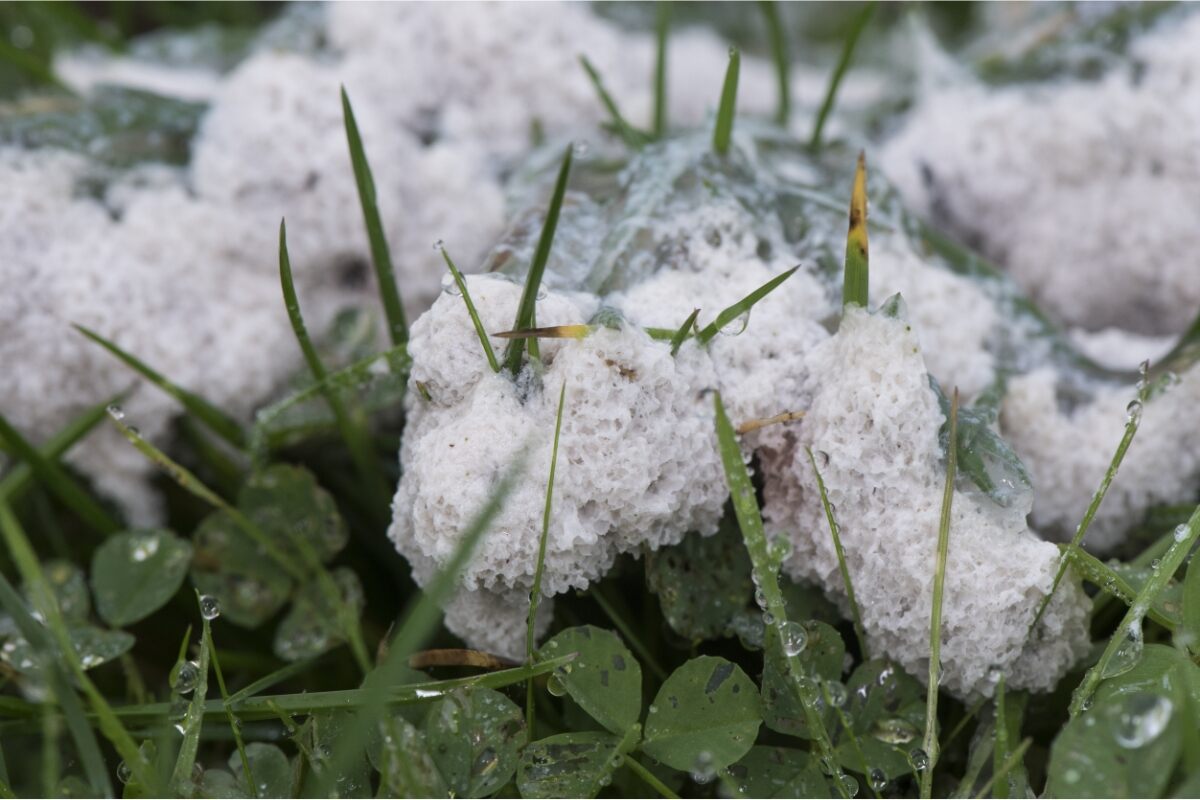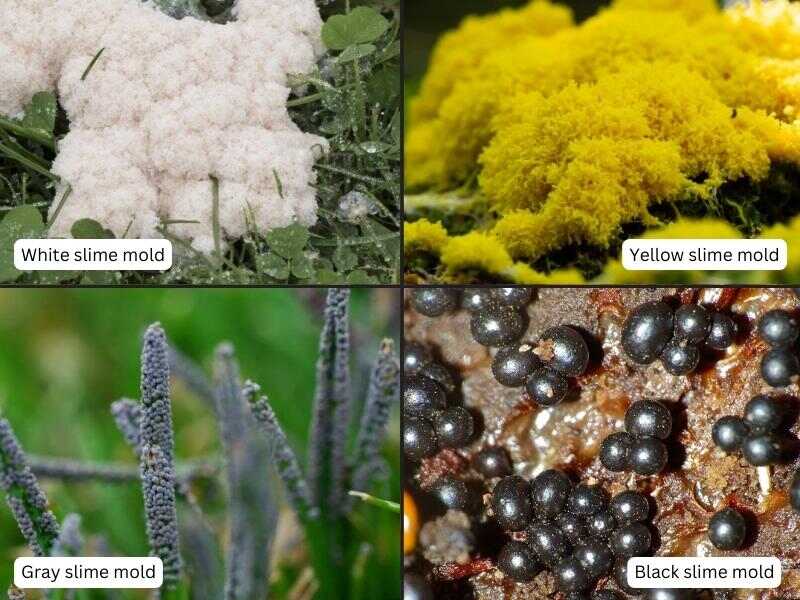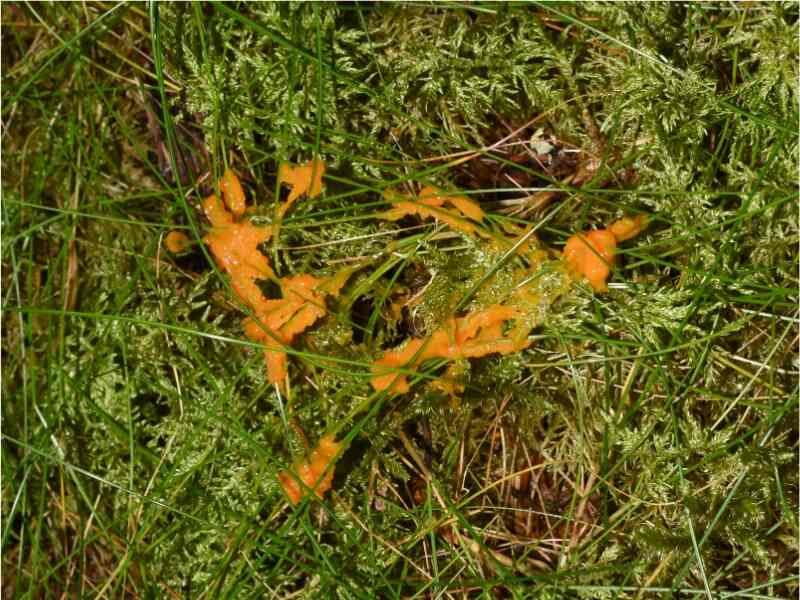
Slime mold is a unique single-celled organism that can show up as slimy or crusty patches of white, black, gray, brown, yellow, orange, or purple on your lawn. Even though it spreads via spores, like a fungus, it isn’t a fungal lawn disease. In fact, its only harm is that it looks gross. Because slime mold is not a plant pathogen, it is generally innocuous to your lawn and vanishes on its own. It’s also non-toxic for humans and animals.
Since slime mold isn’t harmful or poisonous, you don’t even have to get rid of it. But if you just can’t stomach a puddle of slime in your front yard, you can eliminate it very easily by blasting it with water or manually removing it with a shovel or rake.
If you want to learn more about the weird world of slime molds – what they are, why they’re growing in your lawn, how to identify and prevent them, etc – this article is for you. By the end, don’t be surprised if you find out that you and slime mold may be distantly related cousins!
What is Slime Mold?
Sometimes known as “dog vomit fungus,” slime molds appear as slimy patches in the grass that can be circular or irregular in shape. They may be brightly colored – yellow, purple, or orange – or more subdued – brown, black, gray, or white. Their sliminess fades to crustiness as they dry out over time.
But other than disturbing your retinas with their unsightly appearance, these unwanted lawn inhabitants do not cause lawn disease in turfgrass, nor is slime mold itself a disease. These organisms (which are not, in fact, fungi) use grass stems and leaves to support their reproductive spore clusters. Slime molds also use turfgrass as structural support when the spores aggregate to find food.
We say slime molds, plural, because there are more than 900 species of organisms that use the “slime mold” label. Many slime mold species produce sporangia or spores, which are also called fruiting bodies. The fruiting bodies are about the size of a pinhead, and when thousands of them come together on turfgrass, they form small circles or irregular patches. The color of those patches depends on the species of slime mold.
The fruiting bodies eventually turn crustlike. When they disintegrate, the mass of spores is disbursed by wind, water, mowers, and foot traffic. The spores germinate, ultimately clump together, and turn into the greasy, slimy blobs that invade the grass after several days of cloudy and wet weather. This oily blob is called plasmodium (a fancier word for slime mold).
Does Slime Mold Hurt Grass?
Now, for the good news: slime mold is rarely harmful to your lawn and can be a blessing in disguise! Slime molds are saprophytes, meaning they eat decaying and dead organic matter. This helps decompose organic material. Why is your grass blessed by this process? Breaking down these substances eliminates plant pathogens and bacteria that could be harmful to your lawn.
A particularly large growth of slime mold may prevent your grass from conducting photosynthesis and cause the leaf blades to turn yellowish. But slime molds tend to disappear as quickly and mysteriously as they appeared in the first place, and the grass will return to its normal color once the slime mold is gone.
Still not ready to roll out the red carpet for slime mold? We got you. Keep reading to find out how to get rid of it and even more importantly, how to prevent it in the first place.
How to Identify Slime Mold

First, you have to make sure it’s actually slime mold and not a fungal lawn disease growing on your grass. Slime mold has many different species, and different varieties have their own unique look.
The most common types of slime mold found on grass are:
- Yellow slime mold: The species Fuligo septica is usually bright yellow, often said to resemble dog vomit or scrambled eggs, and sometimes has a sponge-like texture. It can also be white or gray in color. Yellow slime mold grows most often on decaying plant matter, so it’s likely to appear on lawns with lots of thatch, leaves, or other debris. However, it can also grow on living grass and other plants.
- White slime mold: Also known as dog vomit fungus or dog sick fungus (even though it isn’t a fungus), the species Mucilago crustacea is the one most often said to look like dog vomit. It is one of the larger species and ranges from yellow to white in color. It often grows in a mass or masses of cloudy white.
- Black slime mold: Many species of slime mold produce small, spherical, black fruiting bodies, sometimes called “black pearls.”
- Gray slime mold: The species Physarum cinereum, colloquially known as “UFO ash,” has a powdery rather than oily or slimy texture. It is typically white or gray and appears as little balls growing in clusters on grass blades.
Young spores are usually sticky and turn into a dark and powdery texture when dry. You may be greeted by a purple blob on your grass and wonder if it’s silly putty or clay. Its sudden appearance overnight may be startling, but don’t panic. It’s not ominous. These blobby creatures can be rubbed or wiped off when they are dry.
How to Remove Slime Mold
Although slime mold does not hurt grass, you probably don’t want it sticking around. You’ll be happy to know it typically disappears within a week.
But if you don’t want to wait for the slime mold to leave on its own, here are some ways you can manually remove it from your grass:
- Spray it with a strong stream of water
- Use a shovel to scoop it off
- Rake or mow the lawn
- Dethatch the lawn to remove decaying plant matter (a common cause of slime mold) along with the slime mold itself
Renovation: Lawn areas with heavy thatch or inadequate drainage may experience repeated episodes of slime mold infestation. Improve soil drainage in these areas by dethatching and aerating the lawn regularly. Drainage systems such as French drains can also be helpful.
Fungicides: There’s absolutely no reason to use fungicides or other chemical controls on slime molds. For one, fungicides will not stop slime mold’s spore masses from growing. For another, slime mold is less harmful to the grass than the fungicides themselves, which can damage the soil structure and hurt beneficial organisms, such as earthworms and pollinators.
Why Did Slime Mold Grow on Your Lawn in the First Place?
The build-up of organic matter can cause slime molds. Poor drainage and extensive thatch can exacerbate the problem. When grass is wet for too long, it can lead to slime mold growth overnight. Here are some other causes of slime mold development:
- Wet and warm weather
- Damp soil
- Inadequate sunlight
If you live in a warm area of the country, your yard may be more prone to slime mold spores, especially after heavy rainfall.
It’s a relief to know that slime mold disintegrates on its own when the grass dries. However, the fruiting bodies leave spores that generate more of the organism. The mold predominantly reappears on lawns with inadequate drainage, abundant shade, or substantial thatch accumulation.
Slime Mold Prevention Tips

The best strategy to manage slime mold is to prevent its occurrence. While you cannot do anything about the warm, wet weather that naturally produces slime molds, you can implement lawn care practices that reduce the chances of slime mold choosing your yard for a vacation spot. Many of the prevention methods are the same as the elimination techniques.
Since slime mold develops when organic matter builds up, homeowners should do things regularly that reduce organic material accumulation. These practices will decrease organic matter pile-up:
- Rake up leaves and other debris regularly, especially in the fall.
- Don’t leave your grass clippings on the lawn unless you have a mulching lawn mower that breaks them up into little pieces.
- Mow the lawn once a week during your grass’s growing season.
- Dethatch the lawn once a year.
- Aerate the soil every few years or even annually if you have heavy clay soil to prevent water from pooling around your grass.
Too much water also promotes slime mold growth, so don’t overwater the lawn. About 1 to 1.5 inches of water per week should be sufficient for your grass’s growth. Water early in the morning so the grass blades can dry in the sun over the course of the day.
Take measures to ensure your lawn receives ample sunlight. Pruning shrubs and trees will help minimize sun blockage.
Slime Mold Fun Facts!
Slime molds are interesting creatures. Although they may resemble something from a sci-fi movie, they are harmless. They will not sprout huge alien teeth and devour you. However, they are beneficial to the environment and your lawn and garden because they will devour organic matter that – if not eliminated – could cause plant pathogens and bacteria that are harmful.
Slime mold is a primitive organism that has characteristics of fungi and amoebae. Amoebae are single-celled, asexual organisms. Like amoebae, slime molds reproduce by dividing themselves into new cells.
The jury is still out on whether slime mold is a plant, animal, or fungi. Slime mold has been classified and not classified as each of these. But there is a unanimous decision on one thing: slime mold is a heterotroph!
Heterotrophs are organisms that get nutrients and energy by eating other animals or plants. That means humans are heterotrophs, too! So, you have a little bit in common with that slimy blob on your grass. But if you see slime molds on your lawn, don’t feel threatened. We don’t think slime molds will replace humans anytime soon.
Either allow the mold spores to serve their function in the food chain and gobble away that dead organic matter, or let them know they are not welcome by removing them with water or a shovel. Whatever you choose to do, just don’t be afraid! Remember, slime molds are completely harmless to everyone except dead plant matter.
FAQ About Slime Mold on Grass
Is slime mold harmful to humans and pets?
No. Fortunately, other than being uneasy on the eyes, slime mold is not harmful to humans or fur babies.
When is the best time to remove slime mold?
If you wait for the weather to become dry and hot, slime mold will disintegrate and remove itself. But if the mold’s unsightly appearance outweighs your patience, dry weather is one of the best times to remove it by raking it off of grass blades.
Can slime mold infect my garden, too?
Yes, it can. Fortunately, just like slime mold is not harmful to the grass, it is not harmful to your garden, either. Slime mold doesn’t feed on living plants. If it appears in your garden, the mold is eating dead organic matter, like mulch, compost, or bark dust.
How large are slime molds?
The slimy circular or irregularly shaped patches typically have a diameter of about 4 to 8 inches.
When to Call a Lawn Care Pro
The presence of this unappealing, oily blob that has the power to recreate itself independently may be a little more than you can handle. Fortunately, slime molds are easily removed, and using fungicides to treat them is unnecessary. Fungicide applications are even strongly advised against.
But not everything in your lawn is as easy to deal with as slime molds! If you need help with weed control, pest control, disease control, or even simple lawn care tasks like mowing and fertilizing, LawnStarter can connect you with the best lawn care pros in your area who can do it all. Reach out to a local pro through our online platform for a free quote on more than 30 outdoor services today.
Main Photo Credit: Juan Francisco Moreno Gamez / Canva Pro / License